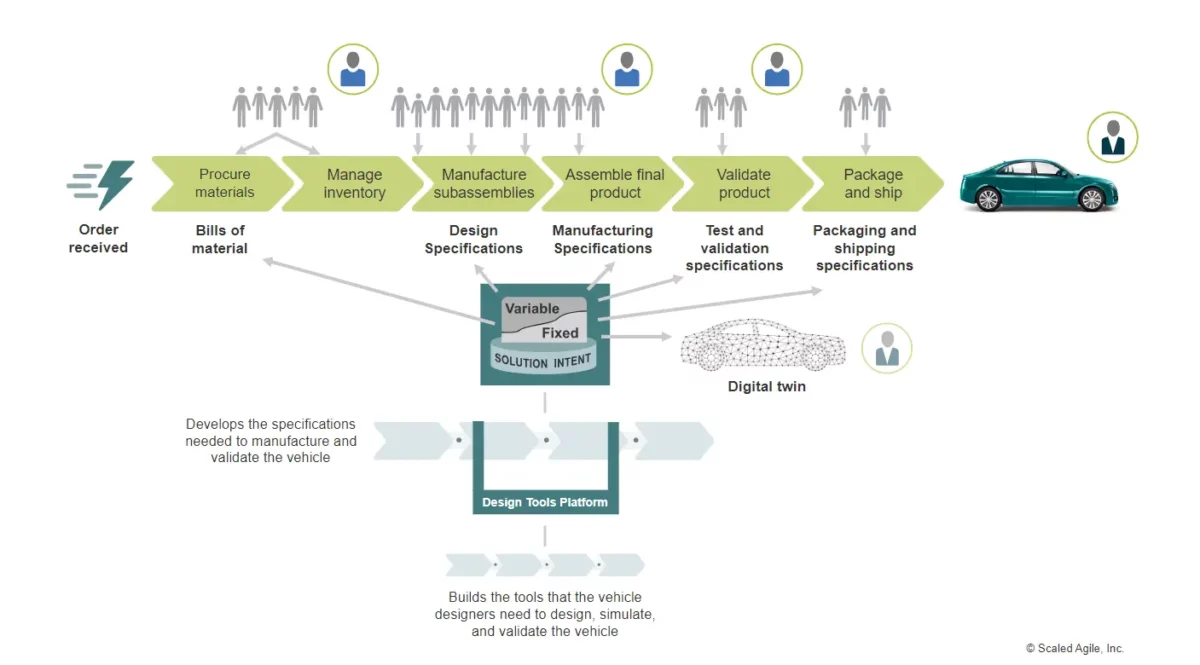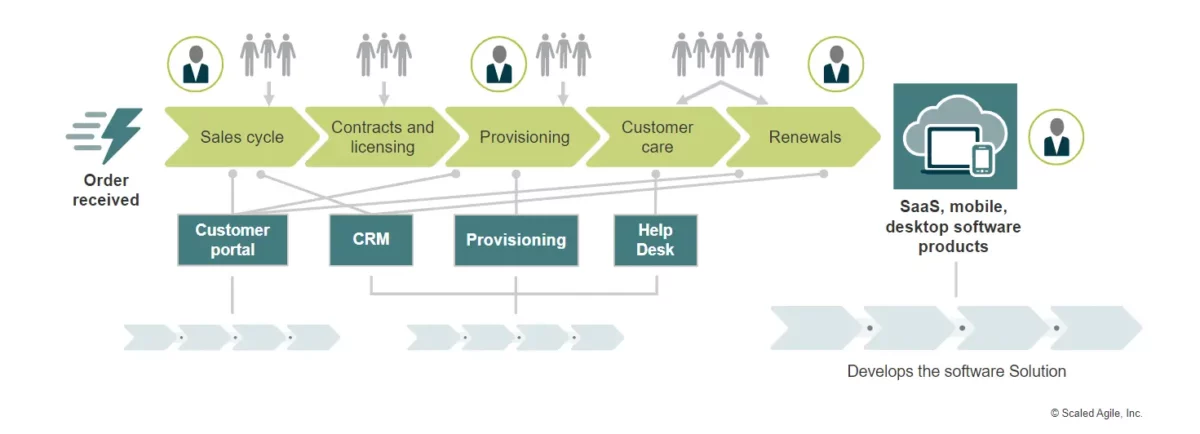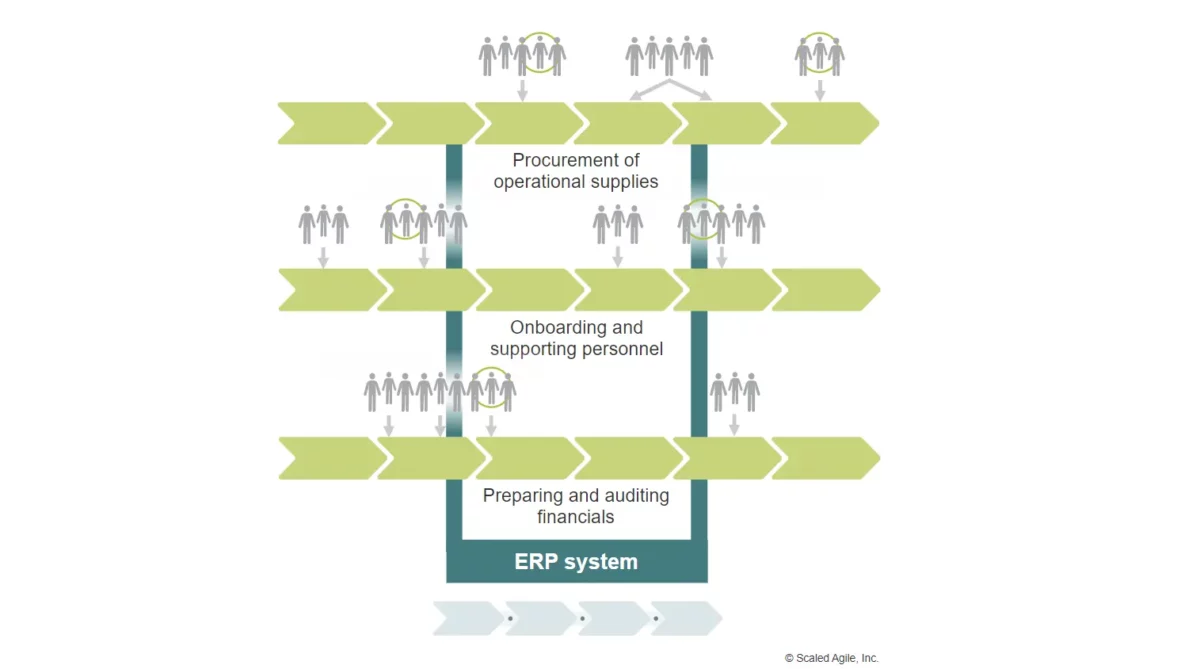Value streams are essential processes that organizations use to create solutions that provide customer value. Within the Scaled Agile Framework (SAFe), two types of value streams are operational and Development.
Development Value Streams (DVS) represent the sequence of activities required to convert a business idea into a digitally-enabled solution and play a critical role in SAFe implementations by optimizing the flow of value across divisions and functions.
In this post, we’ll provide a comprehensive overview of DVS; from defining them and their importance to optimizing DVS boundaries and deliverables. You’ll learn key DVS concepts and patterns that will help you accelerate time-to-market and improve workflow efficiency.
Defining Development Value Streams
Development Value Streams (DVS) are different from Operational Value Streams (OVS). While OVS represent the steps to deliver a product or service to a customer, DVS comprise the activities to develop and support the solutions used in OVS.
For example, an OVS would be a bank providing a loan to a customer. The DVS on the other hand would build the loan origination and core banking systems needed to issue that loan.
Though OVS steps vary based on purpose, DVS steps are relatively standard:
- Define: Activities to define features based on new requests
- Build: Developing the requested features
- Validate: Testing and validating the built features
- Release: Deploying validated features into production
Elements of Development Value Streams
The DVS flow has some key elements:
- Trigger: A new feature request entering the DVS
- Steps: Define, build, validate, and release activities
- Bars: Handoffs between steps as features get developed
- Ellipses: Delays between steps that increase lead time
- Output: New increment of solution value from released features
One DVS can have multiple features moving through these steps simultaneously. The goal is to optimize the flow by reducing delays, handoffs, and batch sizes.
The key outcome of a DVS is the delivery of a solution with incremental value from new features.
This provides business benefits from faster time-to-market and workflow improvements. For example, new features in a loan origination system can reduce loan processing time.

Why Organize into Development Value Streams (DVS)?
Organizing people into Development Value Streams (DVS) provides several benefits. These include:
- It improves workflow by focusing on value delivery across divisions. Teams can visualize dependencies and bottlenecks.
- DVS accelerate time-to-market as new features can flow faster through a streamlined process.
- Stable, long-lived teams get formed around delivering solution value. Knowledge grows within teams.
- Value flow is optimized for customers by reducing handoffs between siloed departments.
- DVS provide a funding model based on value streams rather than projects. Resources are allocated to enable continuous value delivery.
Essentially, DVS align budgets, resources, and talent to improve the flow of features from ideation to deployment. Rather than siloed teams, you get a dedicated end-to-end stream that can rapidly respond to changing customer needs.
By modeling DVS, you can measure and improve productivity through metrics like lead time and throughput. Optimizing DVS also reduces waste from handoffs, delays, and rework.
DVS are integral to achieving the core aim of delivering value quickly and efficiently, and empowering decentralized decision-making within teams. This facilitates faster innovation and experimentation.
Patterns for Development Value Streams
There are some common Development Value Stream (DVS) patterns that emerge for different operational models:
1. Fulfillment DVS Pattern
The fulfillment pattern is typical for industries like banking, insurance, and financial services that offer complex digital products/services to consumers (B2C) and businesses (B2B).
For example, a consumer loan fulfillment process has steps to:
- Attract customers
- Originate loans
- Make eligibility decisions
- Set up payment terms
- Provide the loan amount
- Manage repayment
The solutions supporting this include:
- Front-end customer channels
- Loan origination system
- Credit scoring system
- Core banking system
Multiple DVS can support these systems – one for customer channels, and another for banking services.

2. Manufacturing DVS Pattern
For physical products like vehicles, the DVS focuses on creating specifications and designs for manufacturing rather than the product itself.
In vehicle manufacturing, typical DVS activities are:
- Design styling and industrial design
- Mechanical engineering
- Electrical/electronics engineering
- Software engineering
- Manufacturing engineering
The solutions are the specifications required for production:
- 3D models, drawings, BOMS
- Simulations, analyses, prototypes
- Embedded software code
- Production tooling, assembly steps
Often, supporting DVS build tools for design, validation, and collaboration.

3. Software Products DVS Pattern
Independent software vendors (ISVs) develop commercial software products. The DVS directly works on the software solution itself.
For an enterprise software company, the DVS focuses on:
- Core application capabilities
- Integration services, APIs
- Cloud deployment
- Security, compliance
- Customer support systems
While customers only see the software product, substantial DVS efforts happen behind the scenes – DevOps, IT, operations, sales, and marketing systems.

4. Supporting DVS Pattern
This DVS pattern supports internal business operations like audits, HR functions, supply chain, and research.
For example, an ERP system DVS provides solutions for:
- Finance, Accounting
- Inventory, warehouses
- Procurement, vendors
- HR management
- Reporting, analytics
The users are internal employees and departments, not external customers. However, DVS teams still apply customer-centric thinking for internal users.
Optimizing these DVS patterns improves specific types of operational value streams.

Defining DVS Boundaries and Deliverables
Once you have identified potential Development Value Streams (DVS), additional analysis is required to define the boundaries and scope.
The Development Value Stream Canvas is a simple framework to capture the details of a DVS:
- Purpose: Problem being solved for customers
- Products: Solutions being built and supported
- Process: Main steps in the DVS flow
- People: Roles involved in the DVS activities
- Culture: Behaviors that drive performance
- Customers: Internal and external users of DVS solutions
- Metrics: KPIs to measure DVS outcomes
- Constraints: Challenges and bottlenecks
The canvas helps clearly identify all outputs of the DVS:
- Solutions, platforms, applications
- Features, capabilities, code
- Technologies, tools, infrastructure
- Hardware, devices, equipment
- Services, support, maintenance
It also captures the people involved in delivery – teams, roles, skills.
Another technique is to validate DVS scope against the pipeline of upcoming work – new features, epics, and initiatives. The DVS structure should allow clear ownership of work items to teams. If work cuts across multiple DVS, it may signal misalignment.
Defining the correct DVS boundaries is an iterative process. As workflows and solutions evolve, the DVS design needs to adapt accordingly.

Optimizing Development Value Streams
Once Development Value Streams (DVS) are established, the next step is optimizing them for productivity, quality, and flow. Some techniques include:
- Value stream mapping visually depicts the current state of a DVS. It highlights bottlenecks like wait times, large batch sizes, and information silos, while root cause analysis drives targeted improvements.
- A continuous delivery pipeline automates the building, testing, and deployment of solution increments enabling faster flow and feedback. Advanced implementations use emerging DevOps practices like infrastructure-as-code and shift-left testing.
- Actionable metrics like cycle time, lead time, and throughput create visibility. Comparison to benchmarks drives evidence-based changes.
- Smaller batches and work-in-progress limits reduce queue lengths and wait times.
- Automation of repetitive tasks improves consistency and frees up teams for innovation.
- Shared services and tools also accelerate innovation by reducing redundant work.
The business benefits from optimizing Development Value Streams include:
- Faster time-to-market from higher throughput and reduced delays
- Higher quality through failing fast and preventing defects
- Predictability through managing flow and quantifying variability
- Better customer outcomes from rapid iteration and feedback
Optimizing DVS requires active, ongoing engagement from all stakeholders – not just development teams. The vision should be institutionalizing principles like ‘deliver fast’ and ‘learn rapidly’ across the organization.
Conclusion
As detailed in this post, Development Value Streams (DVS) are key in optimizing the flow of value in SAFe implementations.
As your organization adopts SAFe, pay close attention to modeling and improving your DVS. They are invaluable for delighting your customers with speed and quality. Optimize the DVS, and the enterprise will transform.





